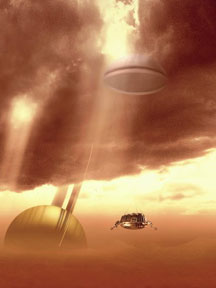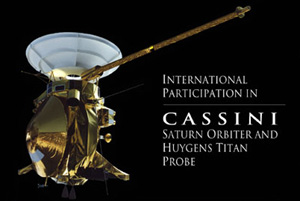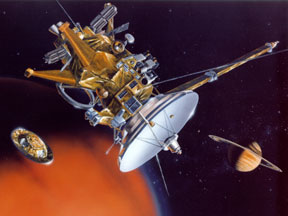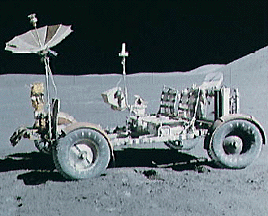Click on image for full size
Image courtesy ESA.
Related links:
Animation of Huygens release from Cassini (1.7 MB QuickTime, courtesy NASA)
Animation of Huygens descent through Titan's atmosphere (3.9 MB QuickTime, courtesy NASA)
Animation of Huygens landing on Titan (1.5 MB QuickTime, courtesy NASA)
NASA Cassini/Huygens mission page
ESA Cassini/Huygens mission page
Huygens Probe to Titan
The Huygens space probe landed on Saturn's moon Titan in January 2005. Huygens made measurements of Titan's thick atmosphere and took pictures of the moon's surface. The probe was built by the European Space Agency.
Huygens hitched a ride to Saturn on the back of NASA's Cassini spacecraft. Cassini "let go" of Huygens on December 24, 2004. Cassini will continue to orbit Saturn, studying the planet and its many moons and rings, for at least four years. Huygens landed on Titan on January 14, 2005.
A heat shield protected Huygens as it entered Titan's upper atmosphere. Next, a series of parachutes slowed the probe down and gently lowered it through the moon's dense atmosphere. Huygens took measurements of the atmosphere as it descended. Finally, the probe landed on the cold (-178º C, -288º F) surface of Titan. Huygens continued to send back data for a couple of hours after it touched down.
The Huygens probe had several instruments that measured Titan's atmosphere. The instruments measured things like the temperature, wind speed, pressure, and the types of gases in the atmosphere. The probe had a camera that took several hundred pictures on the way down. Huygens also had instruments that will help us learn about the icy ground that it landed on.
The probe was named after Christiaan Huygens, a Dutch astronomer. Huygens discovered Titan in 1655.














